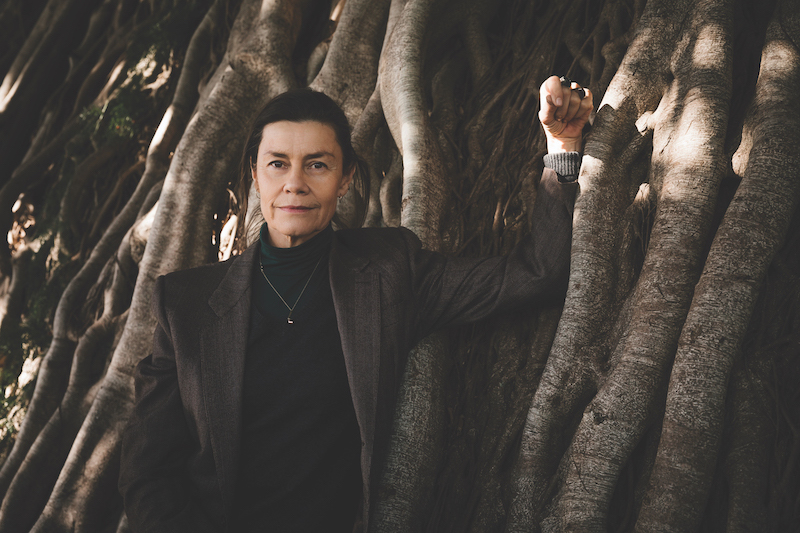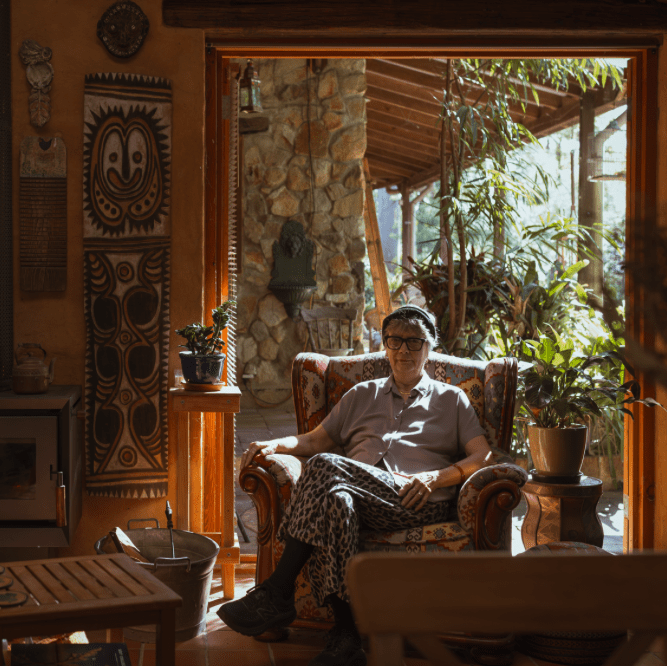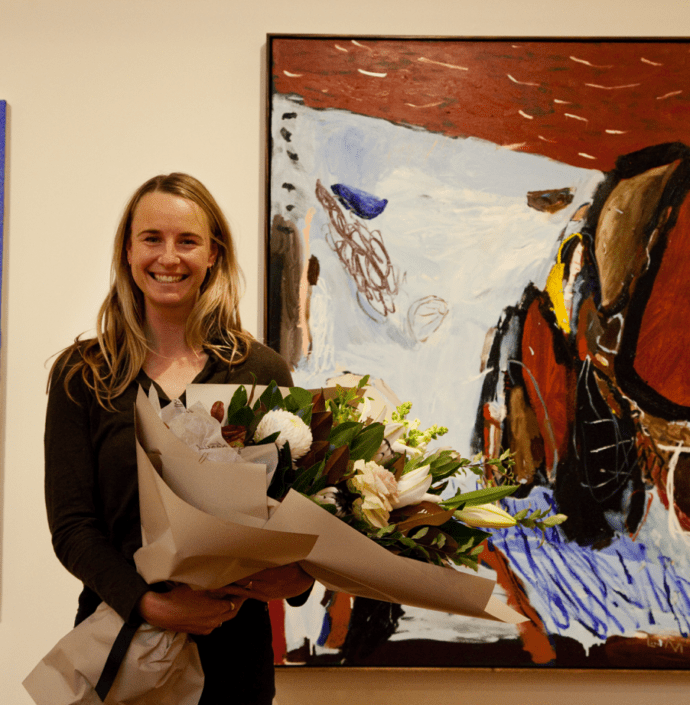Adrienne Gaha: Through rose-coloured glasses
What drives Adrienne Gaha’s latest work is the myriad different interpretations waiting to be discovered in paint.
Words: Louise Martin-Chew
Portrait: Jacquie Manning
ADRIENNE GAHA’S recent paintings involve a lot more colour. The artist has also been playing with pink, building into the sense of nostalgia and history that characterises her practice. This, says Gaha, is “in part is a reaction to having done so many monochromatic images. There is an escapist element too, like looking at the world through rose-coloured glasses.”
This work will be shown in her first exhibition with Martin Browne Contemporary in Sydney and has been made while she is living and working in Sydney (due to Covid-19 travel restrictions) – a change from her usual peripatetic lifestyle between Europe and Australia. She and partner – fellow artist Tim Maguire – have spent decades in France with brief visits to Sydney (since Maguire was awarded the 1993 Moët and Chandon Fellowship). “It’s the first full winter we have had in Sydney in about five years,” says Gaha, “a place that is so beautiful during these months. We are getting a lot of work done in the studios without the constant fascinating distractions of doing up our crumbling house in France and staring at the cats.” The artist is also represented in Melbourne by Kalli Rolfe Contemporary Art.
Her new work is in part inspired by a 17th-century painting titled Orpheus and the Animals by Hans-Beu. But Gaha has shifted focus somewhat. “I am moving away from the body and painting more landscapes with a particular interest in deep shade, as a haven from intense heat. Some of these paintings have human bodies hidden in their depths, or light shining through canopies which falls on boughs or lights up dust motes and insects.” Her medium remains the same – oil paint with various thinning media – and she is still working from found or photographed imagery in a very subjective way. “What drives these paintings,” she says, “is how the paint might open the image to different interpretations around a more or less recognisable subject.”
Oriental 2 (2020) shows an at first abstracted central image on a dripped and rubbed back background, which opens into a figure and a camel carrying a feathery load. Behind it the landscape appears elevated, with a castle that might be straight out of the Disney flagship, although its features are overpainted, indistinct. There is the suggestion of a horizon and sky behind the central figures, and grasses hold the foreground. The paint application, sometimes thin, at other times pooled and veiled, keeps you looking for the potential identities of objects in its depths.
Strange Tree (2020) is a small painting made, Gaha says, “at the end of the day to use up the paint mixes I have created”. This subject is legible, but merges detail of the tree with the background, evocative rather than prescriptive.
Gaha’s work reaches into art history with oblique references to narrative painters like Titian, Rupert Bunny, Bouguereau. The images are rubbed out, painted over, and heavily abstracted, conjoined with contemporary references. Their aesthetic contains touchstones, a sense of familiarity that is hard to pin down but speaks to our recognition of well-known historical paintings and their tropes, juxtaposed with pop culture references (cartoons, the Disney image) and animals. This method of working, where Gaha paints, wipes back with turpentine, glazes, builds, drips and pools paint is, as artist Brooke Fitzsimons suggests, a space where figuration coexists with abstraction in such a way as to address the maxims of modernism. Gaha’s method has been consistent for some decades, although she painted less during the years when her children were small.
She continues: “I’d be lying if I said children didn’t change things and we did fall into the more traditional roles of child-carer and breadwinner, which meant Tim painted a lot more when [the kids] were small. I really loved the child caring role, and I always had the studio close by – just less drive to make work.” Said children are now adults, living in the UK. “I’m in a position to concentrate on making work without too many distractions. I have a beautiful studio [in Sydney] facing south. I’d like to think about projects or residencies in different regions of Australia – and maybe start dancing again!”
The artist-artist relationship is often perceived as uneasy, but for Gaha, it is “really positive. We keep each other going and I never get tired of talking about art with Tim. It’s great to have someone around who wants to see shows, will commiserate over your struggles and enjoy your successes. There are moments when it gets a bit much, usually before a show, where we sneak past each other’s’ studios so we don’t get dragged in for yet another opinion.”
What drives her current practice is curiosity about the way painting works; “how a two-dimensional object is like a key to so many other worlds. Some you know well before you understand them; others work on you slowly. I like to take something from the world that interests me and then explore it through my filter of paint.”
“I first encountered Adrienne’s work as a young curator at the National Gallery of Victoria. We had purchased three huge charcoal figure drawings through the Mitchell Endowment for contemporary art. They were unforgettable. I didn’t know at first whether they were of naked flesh or bronze, but then I learned that they’re based on close-up photographs of a fascistic 1920s neo-classical statue that Adrienne had taken in Düsseldorf. To me, they combined her total awareness of the newest art – the European trans-avant-garde of the 1980s – with traditional centuries-old dedication to technical perfection. She’s a fabulous draughtsman.
“The ever-present push and pull, exploration and play, between old and new is absolutely compelling in Adrienne’s art. While the draughtsmanship that I so admired in her early drawings is still there, her oil paintings are subsumed in veils of colour. They’re exquisitely beautiful, emotionally powerful, often dreamlike. She suggests narratives but never allows them to hold a course.
“Adrienne’s painting process reveals itself in these works in a way that seems quite performative: at once controlled and risking everything (I believe she trained in modern dance, and I imagine her moving in the studio like a dancer). The paintings function as portals into a timeless, beguiling other world of liquid light and colour.
“To me, Adrienne’s paintings are a reminder of the oneness of everything. Her transdisciplinary approach sees Earth as one single, complex, adaptive system driven by constant interactions and feedback loops between energy, matter and living organisms. We know, but we need to really feel, that human activities have increasingly destabilised this system over the last two hundred years or so. We need to cherish that oneness and we ignore it at our peril.
“Although I have only recently begun representing Adrienne Gaha, I have admired her work for nearly 20 years. I am delighted to at last have the opportunity to work with her and I am super excited to be presenting her first exhibition in the gallery in October.
“While clearly grounded in the traditions of figurative painting, Gaha’s images have an elusive – often almost ethereal – nature to them. At a certain moment I feel that I have the image in my mind, only for it to slip away on further looking. Her confidence in expressionist mark-making, combined with a sophisticated understanding of the way that paint can be changed between liquid and solid through the use of solvents, rags and brushes, allows her to push passages of her images into what at close viewing seems like pure abstraction. But pull away from the painting and this abstract section of the work becomes part of the story of the figurative whole. In subject matter, many of Gaha’s works echo classic images from the Western art canon. I love the way that Gaha’s images sit proudly within this lineage yet are refreshed and renewed in the most contemporary of terms. “The kind of collector who Adrienne Gaha’s work will resonate with is first and foremost one who loves painting; a person who appreciates complex and sophisticated imagery, relishes the joy of gestural mark-making and who loves the seduction of colour handled by an artist at the top of their game. My sense is that this exhibition is the start of a golden period in Gaha’s practice. I am honoured that she has entrusted me to be part of it.”
This article was originally published in Art Collector issue 94, October to December, 2020.











